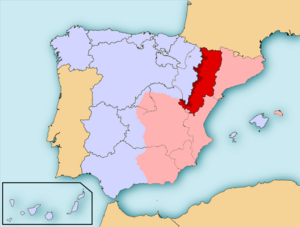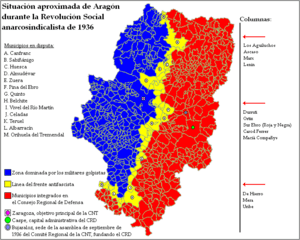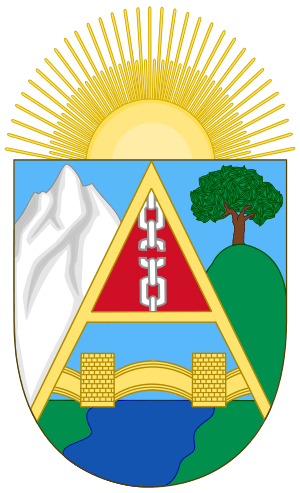Regional Defence Council of Aragon facts for kids
Quick facts for kids Regional Defence Council of Aragon
Consejo Regional de Defensa de Aragón
Consello Rechional d'Esfensa d'Aragón |
|||||||||
|---|---|---|---|---|---|---|---|---|---|
| Autonomous entity of the Second Spanish Republic | |||||||||
| 1936–1937 | |||||||||
 Territory controlled and administered by the CRDA (in red) within Republican Spain (in pink) |
|||||||||
| Capital | Fragaa (until December 1936) Caspea (from December 1936) |
||||||||
| Demonym | Aragonese | ||||||||
| Government | |||||||||
| • Type | Anarchist commune | ||||||||
| • Motto | Honor y Justicia (Honour and Justice) | ||||||||
| President | |||||||||
|
• 1936–1937
|
Joaquín Ascaso | ||||||||
| Historical era | Spanish Civil War | ||||||||
|
• Established
|
6 October 1936 | ||||||||
|
• Legalized by the Second Spanish Republic government
|
23 December 1936 | ||||||||
|
• Dissolved by the Second Spanish Republic government
|
10 August 1937 | ||||||||
|
• Disestablished
|
11 August 1937 | ||||||||
|
|||||||||
| Today part of | Spain | ||||||||
| a. Administrative capital | |||||||||
The Regional Defence Council of Aragon (Spanish: Consejo Regional de Defensa de Aragón (CRDA)) was a special government group. It was created by a workers' union called the Confederación Nacional del Trabajo (CNT). This happened during the Spanish Civil War (1936-1939) as part of the Spanish Revolution of 1936.
The CRDA controlled and managed the eastern part of Aragon in Spain. Its economy was based on local communities working together. They traded goods and controlled prices to prevent things from becoming too expensive.
This Council was the first self-governing body in Aragon since 1707. It acted as its own government within the Second Spanish Republic. At first, it was led by anarchist members of the CNT. Later, from December 1936, other groups from the Popular Front joined its administration.
The CRDA lasted less than a year. It was dissolved by the main Spanish government in August 1937. This happened because the Communist Party of Spain put pressure on the government. Even in its short time, the CRDA introduced new ideas for the economy and society. It supported local communities while fighting in the war.
Contents
A Brief History of the Council
How the Council Started
The idea for the Regional Defence Council of Aragon came from the strong presence of anarchists in Aragon. Many farmers in the region supported the CNT union. When the Spanish Civil War began, a revolutionary situation developed in Aragon.
Workers' groups and militias took control in many areas. They filled the gap left by the military uprising. The main government in Madrid and the Catalan government had little power in Aragon at this time.
After the military coup in October 1936, Aragon was divided. The western side was controlled by forces against the Republic. The eastern side was held by Republicans and anarchists. In these eastern areas, the militias and revolutionary committees held the real power. Most of these groups were anarchists.
On October 6, 1936, a big meeting was held in Bujaraloz. It included representatives from 139 towns and various CNT military groups. They decided to create Regional Defense Councils. These councils would work together under a National Defense Council. This plan was separate from the main Republican government.
The meeting agreed to create the Regional Defense Council of Aragon. This Council included about 450 rural communities. Most of these were run by the CNT, with only a few by the UGT union. The Republican government and the Catalan government were not happy about this. But they had to accept it for the time being.
The main office of the Regional Defence Council was in Caspe. Its leaders said that rural Aragon had become a special place. They did not want to be controlled by other political groups. The Regional Defence Council of Aragon became one of the most important anarchist councils.
A Short-Lived Government
The Council was officially recognized by the government on October 6, 1936. Its first official meeting was on October 15. At this meeting, Joaquín Ascaso, a CNT member, was chosen as President.
The Council was fully legalized by the Republican government on December 23, 1936. But there was a condition: other groups from the Popular Front had to join the Council's administration. From January 1937, the Council's revolutionary ideas slowly became less strong. This was due to pressure from the government groups who joined. For example, primary schools, which anarchists had organized, went back under government control.
Ascaso was officially appointed as a government delegate on January 19, 1937. In February 1937, a large meeting was held in Caspe. About 500 delegates attended, representing 80,000 people from Libertarian Aragon. They met to create a regional "Federation of Collectives."
It is hard to know exact numbers about how well the anarchist communities managed their economy. Reports often had a bias depending on who wrote them. Some historians say that coal production went down a lot. However, other reports and testimonies suggest that production actually increased in many communities.
Even though many collectives were successful as social communities, some thought they did not contribute enough to the war effort. The Republican government wanted to coordinate actions for the war industry. In the summer of 1937, the government started taking food trucks from the communities.
The Council is Dissolved
The Regional Council acted very independently. This always bothered the Republican authorities. After regaining control over Catalonia, the Spanish Republican government decided to break up the Aragonese Council. They were supported by their Republican, Socialist, and Communist allies.
On August 4, 1937, the National Defense Minister, Indalecio Prieto, ordered the Spanish Republican Army to act. The 11th Division, led by Enrique Líster, was sent to Aragon. The Aragon Council was officially dissolved on August 10.
The dissolution happened quickly and by surprise. This was to prevent any resistance. Líster's troops attacked the local CNT union office in Caspe. They also caused some damage to the town. Tanks and artillery were placed at the city's exit. There were some fights and people were injured.
Joaquín Ascaso and other anarchist members of the CRDA were arrested. About 700 other anarchists were arrested across Aragon.
After the Council was dissolved, the government appointed José Ignacio Mantecón as Governor General. He took charge of the Republican territory in Aragon. Mantecón had been a member of the Council. Farmers who had not joined the collectives took back many of them by force. They privatized and shared out the food and equipment.
The CNT Regional Committee offices were taken over. Their files were seized by the Republican authorities. Communist military units also occupied various collectives. CNT leaders tried to prevent anarchists from being harmed. But they eventually accepted that the "Council of Aragon" was gone. Later, when crop yields dropped, some broken-up collectives were restarted. However, they were not the same as before. Many anarchists were held in prisons or camps under Republican control until the war ended.
Who Was in the Council?
Here is how the Council was made up, according to a CRDA report from December 21, 1936:
| Cabinet Position | Office Holder | Political Party or Trade Union | |
|---|---|---|---|
| President | Joaquín Ascaso | CNT | |
| Public Order | Adolfo Ballano | CNT | |
| Information & Propaganda | Evaristo Viñuales Larroy | CNT | |
| Agriculture | Adolfo Arnal | CNT | |
| Labor | Miguel Chueca Cuartero | CNT | |
| Transport & Communications | Luis Montoliu Salado | CNT | |
| Economy & Supplies | Evelio Martínez | CNT | |
| Justice | José Ignacio Mantecón | IR | |
| Finance | Jesús Gracia | IR | |
| Culture | Manuel Latorre | UGT | |
| Public Works | José Ruiz Borao | UGT | |
| Health & Social Assistance | José Duque | PCE | |
| Industry & Commerce | Custodio Peñarrocha | PCE | |
| General Secretary | Benito Pabón | PS |
See also
 In Spanish: Consejo Regional de Defensa de Aragón para niños
In Spanish: Consejo Regional de Defensa de Aragón para niños





